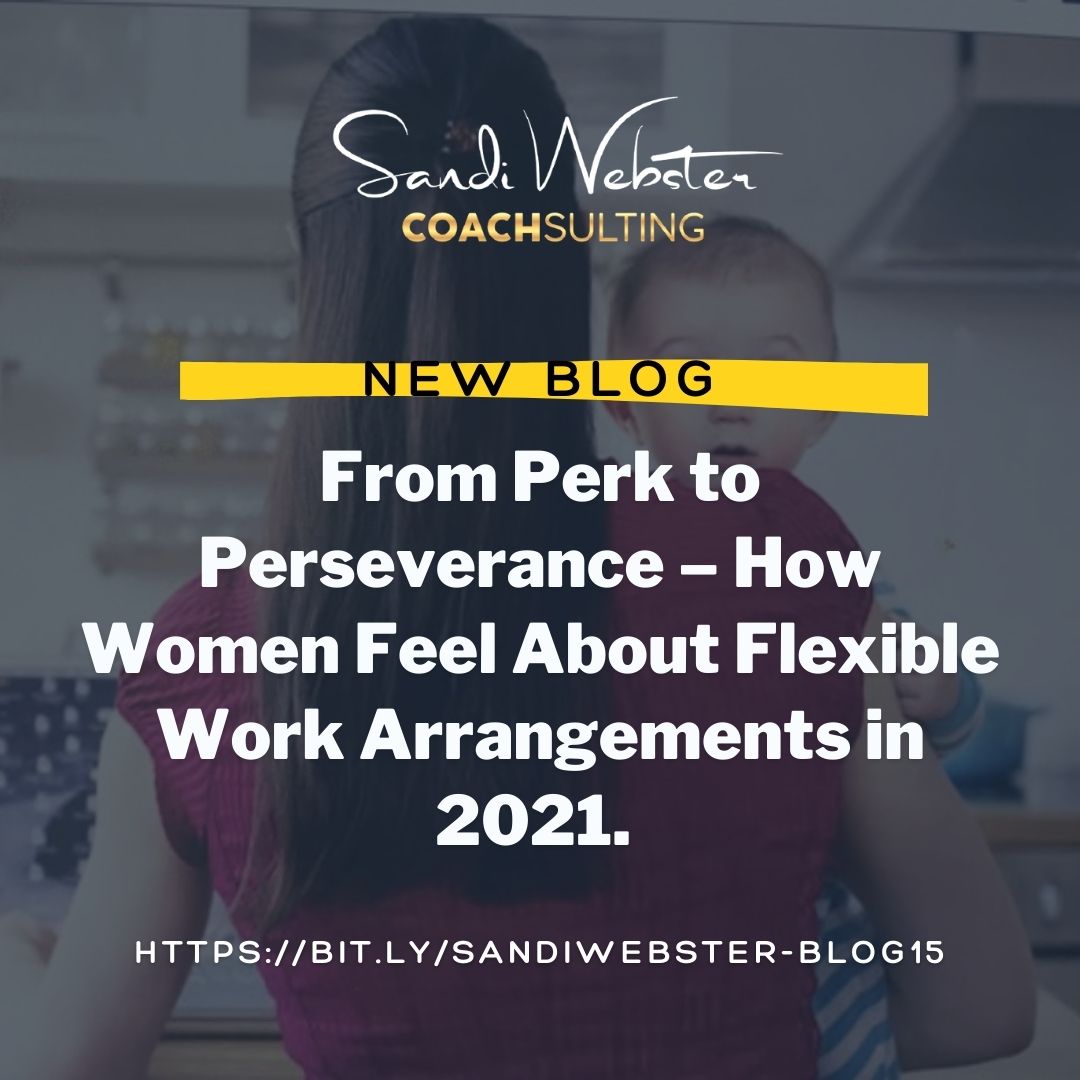From Perk to Perseverance – How Women Feel About Flexible Work Arrangements in 2021
2020 was a year that many women were awaiting – not because of COVID-19, but because, finally, they were able to test out flexible work arrangements (FWA) that were voluntarily given to them by their Human Resource departments! Women had agita asking to work from home because of how they were viewed in the workforce. Then came COVID—the great equalizer—and offices involuntarily closed due to government mandates and defiant employees. Everyone had to work from home or risk their co-workers sneezing or coughing on them or, God forbid, shaking their hand!

Research on flexible work arrangements has increased over the years, including my dissertation, Flexible Work Arrangements: Technology Enabling Emerging Populations of Millennials and Baby Boomers. So, have the reasons that women wanted to work from home changed? Basically, no, the reasons are the same. However, “home” has changed; therefore, the motivation and purpose for working effectively from home have also changed. Some women say they are changing their minds about the office! LOL!
Caregiving has always been the number one reason women wanted to work from home and that has not changed. (Milanesi, 2021. Green, J., et al. 2021). Women of childbearing age were abundant in the corporate marketing departments of Fortune 500 companies where I worked. They felt they had to choose between being a caregiver and having a career. Some women still felt unsupported at work relative to their caregiver roles, fearing that in 2020, they were viewed as unprofessional or unreliable. Since everyone had to work from home during COVID, the bulk of the work still fell to women. Their lives got more intense and pressurized with the added roles of sous chef/baker, teacher, playmate, Zoom master, technician, dog walker, housekeeper, eldercare giver, 24-hour wife, and…getting their work done on time for the job! When is the train going to start running again?? Some women can’t wait to get back to an office.
In 2002, my business partner and I created our former company, Consultants 2 Go, because we saw our friends who were senior executives leave the workforce in droves. They would commute to work every day when they had only one child, but the second child was a dealbreaker! They could not handle the 90-hour workweek with two children. They had to choose sides, and the family usually wins – mainly if the woman was not the primary breadwinner. Otherwise, when the woman leaves the workforce, the family suffers from income loss and must change their lifestyle to accommodate a lesser income. That issue continues to be a challenge for most women. As the return-to-work policies are being crafted, schools and elder daycare have not all opened. Now, women must make a new decision whether or not to return to the office or return to the 2002 days of choosing to quit.
Some companies offered onsite accommodations to help employees with childcare or other caregiving duties. However, these extra accommodations caused tension with some employees. Non-FWA or child-free employees saw this perk as “getting favors.” I had a flexible schedule while working in corporate in 1991. It was one of the first company-sanctioned work-from-home programs for employees – all women. I worked a 40-hour, 4-day week to attend graduate school on Fridays and weekends. Others worked three days in the office and two days from home. We had new, portable laptops that weighed a ton but came with a docking station.
It was accompanied by a token that we needed for the dial-up internet connection. I cannot tell you the number of times I received comments from male and female employees about being the “manager’s favorite” who can “come and go as she pleased.” My work always got done accurately and on time, but it was overshadowed by my “extra day off.”
During COVID, that childcare perk went away, and women, as previously stated, must now be head cooks and bottle washers, even with a spouse in the house. Companies wonder why they paid for those expensive offices and why not just save money and let their employees work from home? The work-from-home environment has changed so they must be ready to help workers adjust to the present unforeseen distractions.
Women were made to feel guilty about leaving work early to care for their families – (“you’re leaving early again?”) Simultaneously, men were applauded for leaving early to go to the gym – (“you’ve got to keep yourself in shape.”) Additionally, women of every management level were constantly insulted when they were asked to be “caregivers” at work by performing caregiver-like duties. These duties included catering for a meeting, organizing an office party, buying a present for a celebration, or walking a guest to a meeting room). Some women expressed feeling guilty about wanting to go back to the office. They are also hoping that men will feel better about taking on some of the office caretaker roles. I will check back in 2022 to see how that worked out!
In summary, how has the perk become persecution? I asked six ladies who now work from home (two are school teachers!), and this is their assessment of pre and post-COVID flexible work arrangements. Names are left off the quotes to protect the guilty.
| PRE-COVID | POST-COVID |
|
1. Flexible hours allowed women to fulfill their caregiver duties. |
Not anymore. More work and having an entire family at home distracts and makes them less productive.
“I might go to jail if this crazy home environment doesn’t change!” |
|
2. Women saved thousands of dollars on childcare – nannies, babysitters, and after-school care. |
Not anymore. Children and the elderly are at home and different accommodations must now be made as to part-time school and distilled elder daycare.
“Who does that? Either you’re open or closed? What’s with the open today, closed next week thing?” “I’ve put in for retirement and am increasing my after-school program fees because these germ-spreaders, I mean kids, come here without a mask, hand sanitizer or anything!” |
|
3. Some women feel unsupported at work in relation to their caregiver roles. (Milanesi, 2021) |
Some women now feel unsupported at home and home office in relation to their caregiver roles.
“It’s definitely changed…for the worse! The office thinks I can be on Zoom 24/7. And the kids expect a gourmet meal instead of hot dogs!” |
|
4. More focused time. Feel secure about productivity (Milanesi, 2021),/p> 5. No micromanagement by their superiors. Some work can be done anywhere as long as there is reliable internet connection and a quiet place to work
|
Time is less focused – too many distractions. Women are insecure about productivity. They are multi-tasking more than ever. Managers who are used to working in the office cannot see them and feel checking in regularly is the way to go.
“How can I be focused with Zoom client meeting on my cell phone going with my cameras off; the dog got used to being walked during the day; I got the kids dressed before the text came that someone tested positive so keep them home; and my boss sent me an email at 7:30am, called my cell phone for an answer at 8:00am, called my house phone at 8:30am, and texted to see why I wasn’t answering at 8:35am while I was on MS Team waiting for him to get on!” |
|
6. Lack of commute time, business travel, meeting room availability challenges allow more focused time to get work done.,/p> |
Work starts early and never ends. Zoom fatigue is taking over from face-to-face.
“I long to sit on a train and read a good romance novel to calm my nerves before going into the office. I don’t need a meeting room – you can come sit at my desk and there will be no kids calling me or dogs barking. I can talk to you without muting myself.” |
|
7. Equalizes the gender role differences and expectations in the workplace (Milanesi, 2021) |
Gender differences are more pronounced when everyone is in the same space. The default household chores and childcare regressed to the woman.
“Jesus take the wheel! I have not done this much housework and cooking since college. My husband works from home too but has yet to pick up a frying pan or do the laundry. I don’t even argue about it anymore because it saps my energy.” |
I cannot wait to see how the world will change in another year. Will women run away from home and back to the office where childcare is once again a perk? Will men now like working from home and are willing to help with childcare and household chores? Let’s see how flexible arrangements can benefit everyone in 2022!
Sources:
Green, J., Gonzalez, C. & Fanzeres, J. (2021, June 16). The Return to the Office Is PushingEven More Women Out of Work. Bloomberg. Retrieved fromhttps://www.bloomberg.com/news/articles/2021-06-16/return-to-office-is-pushing-even-more-women-out-of-work?
Milanesi, C. (2021, March 11). For Women, Working From Home Comes With Strings. Forbes. Retrieved from https://www.forbes.com/sites/carolinamilanesi/2021/03/11/for-women-working-from-home-comes-with-strings/?sh=6b4bbdbf3aa2
Webster, S. (2018). Flexible Work Arrangements: Technology Enabling Emerging Populations of Millennials and Baby Boomers. Temple University. ProQuest Dissertations Publishing. 10808781.


